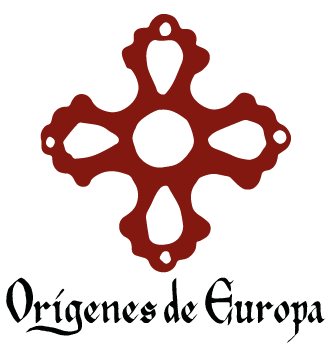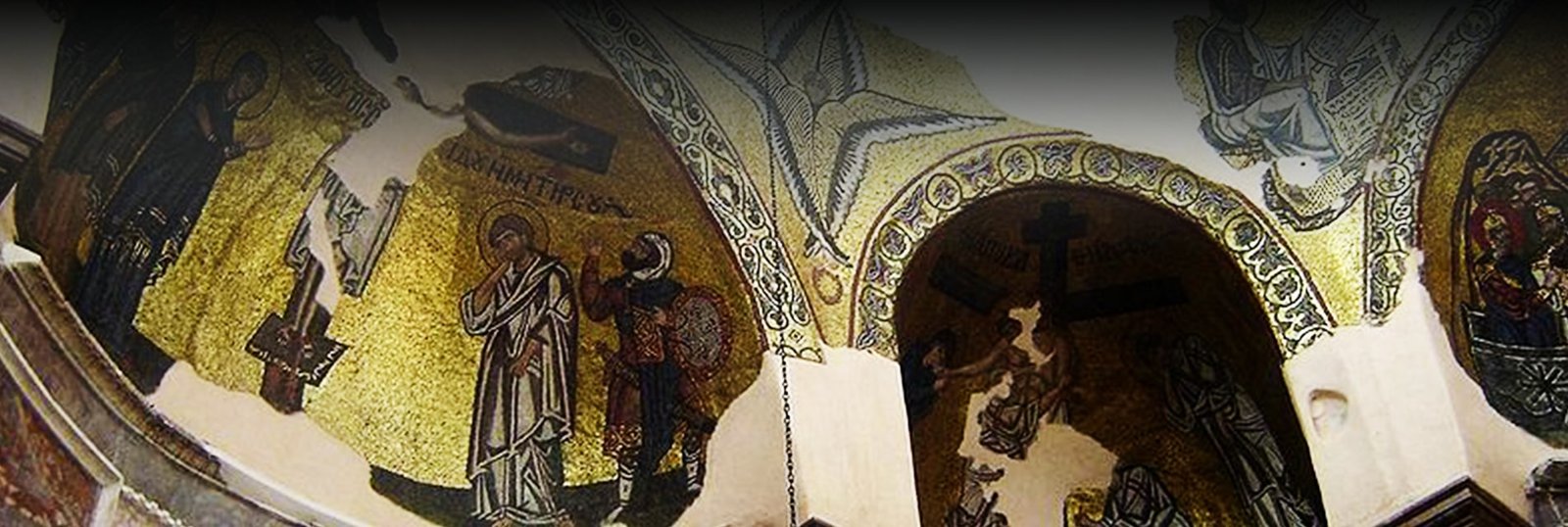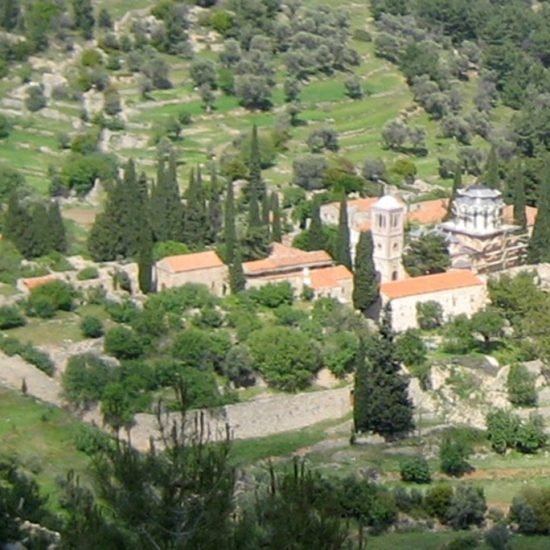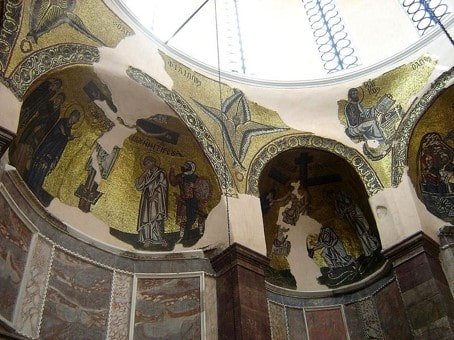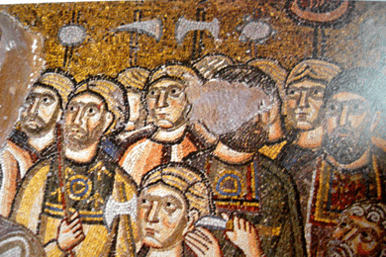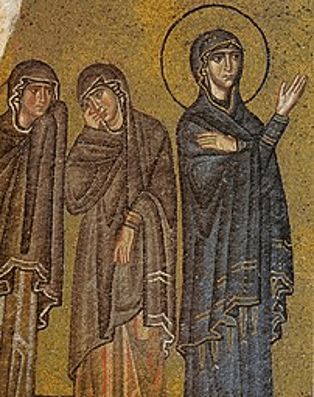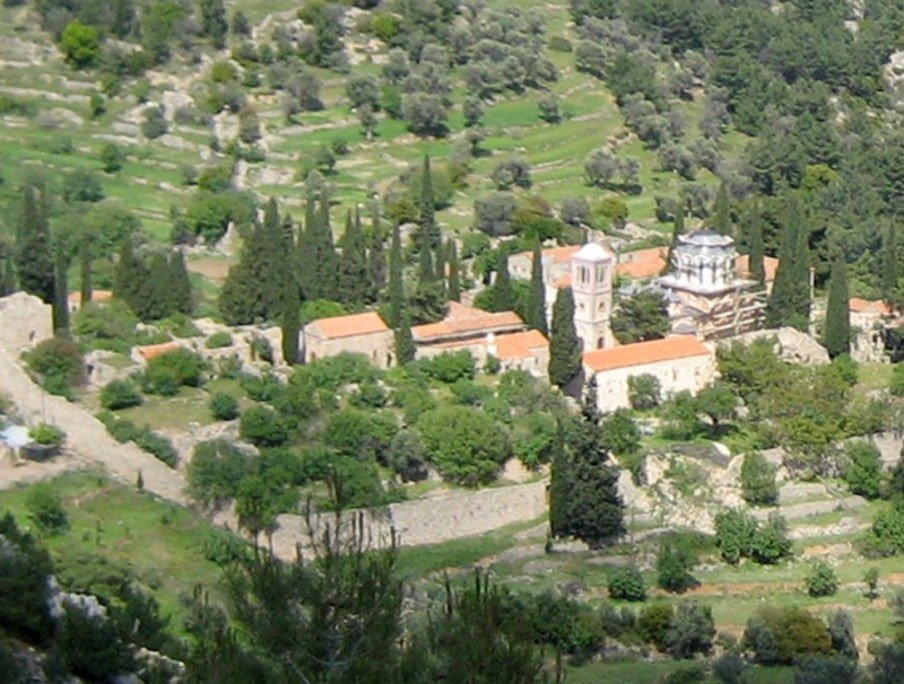Nea Mone
per person
Founders of the monastery of Nea Mone, dedicated to Virgin, are the emperor Constantine IX Monomachos and the empress Zoe. Its construction started in 1042 and finished in 1055, that is after the death of the Emperor.
Due to lavish donations through imperial decrees, the monastery became one of the biggest landowners on the island in the middle ages. After a short decline with the Genoese presence on Chios, Nea Mone flourished during the Ottoman period. With the Greek Revolution and the War of Independence, Chios and the monastery was destructed in April 1822. The katholikon suffered more damage and the dome collapsed by an earthquake in 1881; also, the bell-tower dated in 1512 was destroyed. In 1952, the until then male monastery was converted into a nunnery, a practice very often attested in Byzantium.
FORMAL ANALYSIS
The complex was surrounded by walls and a tower which stands on the northeastern segment of the circuit and was used also as library. The monastery included various buildings such as the now ruined refectory (trapeza), the cells of the monks and two other churches. However, the cells date to the Venetian and Genoese period of the complex.
The 11th century katholikon is divided in the naos (main part of the church), the esonarthex and the exonarthex. Contrary to important monuments of the 11th century mainland, this church is not of a cross type but of an octagonal shape. The octagonal form is found in churches on islands like Chios and Cyprus and is also known as the insular type.
Nea Mone is well known for the exceptional mosaics which belong to the best from the middle byzantine period. Their topics cover the christological circle wich scenes such as the Crucifixion and Resurrection. It is commonly accepted that they were created by Constantinopolitan artists.
EKATERINI MITSIOU
- NEA MONE © FOTo: Maarten Sepp, wikipedia commons, https://de.wikipedia.org/wiki/Nea_Moni#/media/Datei:Nea_Moni_(general_view).jpg
- NEA MONE © PLAN: wikimedia commons
- INNER SPACE OF THE MONASTERY WITH MOSAICS © FOT. © John Karakatsanis, https://antonioheras.com/patrimonio_ humanidad/europa/index1190.htm
- Arrest of Jesus mosaic (11th) © FOT. https://hmong.es/wiki/Nea_Moni_of_Chios
- MONASTIC MAIN CHURCH (EXTERIOR) © wikipedia commons
- DETAILS OF THE CRUCIFIXION, 11TH CENTURY © wikipedia commons
Tour Location
Nea Mone
| Other monuments and places to visit | Nea Mone (New Monastery) at Chios |
| Natural Heritage | Nea Moni is located in the center of the island,12 kilometers from the town of Chios. The architectural complex of the monastery is located at an altitude of 670 meters above sea level, in a valley of the southern Provateios Mountain or Provatas. The area was full of pine trees but now the forest is regenerating after a fire. |
| Historical Recreations | |
| Festivals of Tourist Interest | |
| Fairs | |
| Tourist Office | |
| Specialized Guides | |
| Guided visits | |
| Accommodations | |
| Restaurants | |
| Craft | |
| Bibliography | |
| Videos | |
| Website |
| Monument or place to visit | Nea Mone (=New Monastery) at Chios |
| Style | 11th century, 14th century and later (17th century) |
| Type | Byzantine Monastic architecture |
| Epoch | 11th century, 14th and later |
| State of conservation | Good conditions. |
| Degree of legal protection | Unesco World HeritageSite |
| Mailing address | Karies, Τ.Κ. 82100, Karies, Chios (Prefecture of Hios) |
| Coordinates GPS | 38°22′26″N 26°3′20″E |
| Property, dependency | Municipality of Chios |
| Possibility of visits by the general public or only specialists | General public visits |
| Conservation needs | |
| Visiting hours and conditions | Winter: 8.00-13.00, from 16.30-until sunset Summer: 8.00-13.00, from16.30-until sunset To know the schedules, call the phone: 2271079370 |
| Ticket amount | Free entrance |
| Research work in progress | Restoration and rebuilding after the destructions in the 19th century and and earthquake in 1907 |
| Accessibility | By car |
| Signaling if it is registered on the route | |
| Bibliography | - Charalambos Bouras: Nea Moni on Chios: history and architecture. Athen 1982. Doula Mouriki: The mosaics of Nea Moni on Chios. Athen 1985. Sotiris Voyadjis: The Katholikon of Nea Moni in Chios unveiled. In: Jahrbuch der österreichischen Byzantinistik, 59, 2009, S. 229–242. |
| Videos | Youtube |
| Information websites | odysseus.culture.gr neamoni.gr web.archive.org culture.gr whc.unesco.org odysseus.culture.gr |
| Location | 12km from the city of Chios (island of Chios, Greece) |
